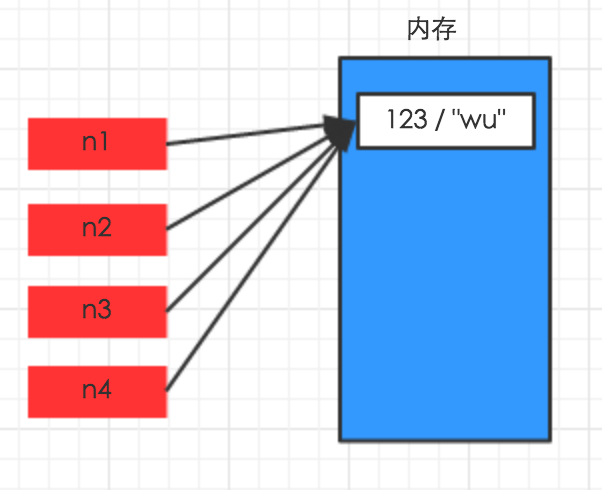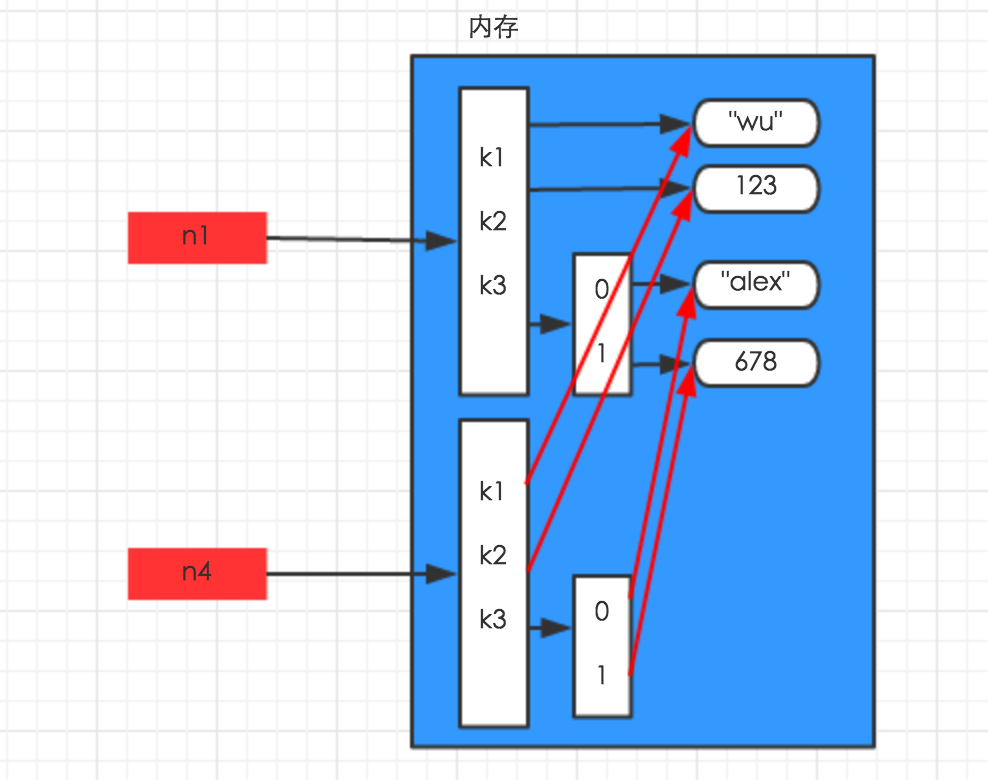三元运算
三元运算(三目运算),是对简单的条件语句的缩写。
# 书写格式
result = 值1 if 条件 else 值2
# 如果条件成立,那么将 “值1” 赋值给result变量,否则,将“值2”赋值给result变量
if 1==1:
name = "wangxin"
else:
name = "yuehan"
#如果1=1成立,name为wangxin,否则...
name = "wangxin" if 1==1 else "yuehan"set
set集合,是一个无序且不重复的元素集合
class set(object):
"""
set() -> new empty set object
set(iterable) -> new set object
Build an unordered collection of unique elements.
"""
def add(self, *args, **kwargs): # real signature unknown
"""
Add an element to a set,添加元素
This has no effect if the element is already present.
"""
pass
def clear(self, *args, **kwargs): # real signature unknown
""" Remove all elements from this set. 清除内容"""
pass
def copy(self, *args, **kwargs): # real signature unknown
""" Return a shallow copy of a set. 浅拷贝 """
pass
def difference(self, *args, **kwargs): # real signature unknown
"""
Return the difference of two or more sets as a new set. A中存在,B中不存在
(i.e. all elements that are in this set but not the others.)
"""
pass
def difference_update(self, *args, **kwargs): # real signature unknown
""" Remove all elements of another set from this set. 从当前集合中删除和B中相同的元素"""
pass
def discard(self, *args, **kwargs): # real signature unknown
"""
Remove an element from a set if it is a member.
If the element is not a member, do nothing. 移除指定元素,不存在不保错
"""
pass
def intersection(self, *args, **kwargs): # real signature unknown
"""
Return the intersection of two sets as a new set. 交集
(i.e. all elements that are in both sets.)
"""
pass
def intersection_update(self, *args, **kwargs): # real signature unknown
""" Update a set with the intersection of itself and another. 取交集并更更新到A中 """
pass
def isdisjoint(self, *args, **kwargs): # real signature unknown
""" Return True if two sets have a null intersection. 如果没有交集,返回True,否则返回False"""
pass
def issubset(self, *args, **kwargs): # real signature unknown
""" Report whether another set contains this set. 是否是子序列"""
pass
def issuperset(self, *args, **kwargs): # real signature unknown
""" Report whether this set contains another set. 是否是父序列"""
pass
def pop(self, *args, **kwargs): # real signature unknown
"""
Remove and return an arbitrary set element.
Raises KeyError if the set is empty. 移除元素
"""
pass
def remove(self, *args, **kwargs): # real signature unknown
"""
Remove an element from a set; it must be a member.
If the element is not a member, raise a KeyError. 移除指定元素,不存在保错
"""
pass
def symmetric_difference(self, *args, **kwargs): # real signature unknown
"""
Return the symmetric difference of two sets as a new set. 对称差集
(i.e. all elements that are in exactly one of the sets.)
"""
pass
def symmetric_difference_update(self, *args, **kwargs): # real signature unknown
""" Update a set with the symmetric difference of itself and another. 对称差集,并更新到a中 """
pass
def union(self, *args, **kwargs): # real signature unknown
"""
Return the union of sets as a new set. 并集
(i.e. all elements that are in either set.)
"""
pass
def update(self, *args, **kwargs): # real signature unknown
""" Update a set with the union of itself and others. 更新 """
pass深浅拷贝
一、数字和字符串
对于 数字 和 字符串 而言,赋值、浅拷贝和深拷贝无意义,因为其永远指向同一个内存地址。
import copy
# ######### 数字、字符串 #########
n1 = 123
# n1 = "i am wangxin age 10"
print(id(n1))
# ## 赋值 ##
n2 = n1
print(id(n2))
# ## 浅拷贝 ##
n2 = copy.copy(n1)
print(id(n2))
# ## 深拷贝 ##
n3 = copy.deepcopy(n1)
print(id(n3))
二、其他基本数据类型
对于字典、元祖、列表 而言,进行赋值、浅拷贝和深拷贝时,其内存地址的变化是不同的。
1、赋值
赋值,只是创建一个变量,该变量指向原来内存地址,如:
n1 = {"k1": "wu", "k2": 123, "k3": ["wangxin", 456]}
n2 = n1 
2、浅拷贝
浅拷贝,在内存中只额外创建第一层数据
import copy
n1 = {"k1": "wu", "k2": 123, "k3": ["wangxin", 456]}
n3 = copy.copy(n1)
3、深拷贝
深拷贝,在内存中将所有的数据重新创建一份(排除最后一层,即:python内部对字符串和数字的优化)
import copy
n1 = {"k1": "wu", "k2": 123, "k3": ["wangxin", 456]}
n4 = copy.deepcopy(n1)
函数
函数式:将某功能代码封装到函数中,日后便无需重复编写,仅调用函数即可
面向对象:对函数进行分类和封装,让开发“更快更好更强...”
函数式编程最重要的是增强代码的重用性和可读性
定义和使用
def 函数名(参数):
...
函数体
...
返回值函数的定义主要有如下要点:
def:表示函数的关键字
函数名:函数的名称,日后根据函数名调用函数
函数体:函数中进行一系列的逻辑计算,如:发送邮件、计算出 [11,22,38,888,2]中的最大数等...
参数:为函数体提供数据
返回值:当函数执行完毕后,可以给调用者返回数据。
1、返回值
函数是一个功能块,该功能到底执行成功与否,需要通过返回值来告知调用者。
以上要点中,比较重要有参数和返回值:
def 发送短信():
发送短信的代码...
if 发送成功:
return True
else:
return False
while True:
# 每次执行发送短信函数,都会将返回值自动赋值给result
# 之后,可以根据result来写日志,或重发等操作
result = 发送短信()
if result == False:
记录日志,短信发送失败...2、参数
函数的有三中不同的参数:
普通参数
默认参数
动态参数
# ######### 定义函数 #########
# name 叫做函数func的形式参数,简称:形参
def func(name):
print name
# ######### 执行函数 #########
# 'wupeiqi' 叫做函数func的实际参数,简称:实参
func('wupeiqi')
普通参数def func(name, age = 18):
print "%s:%s" %(name,age)
# 指定参数
func('wupeiqi', 19)
# 使用默认参数
func('wangxin')
注:默认参数需要放在参数列表最后
默认参数def func(*args):
print args
# 执行方式一
func(11,33,4,4454,5)
# 执行方式二
li = [11,2,2,3,3,4,54]
func(*li)
动态参数def func(**kwargs):
print args
# 执行方式一
func(name='wupeiqi',age=18)
# 执行方式二
li = {'name':'wupeiqi', age:18, 'gender':'male'}
func(**li)
动态参数# def f2():
# print(123)
# r = f2()
# print(r) #python的函数会自动return一个空值None
# def sendmail(xxoo)#形式参数
#
# ret =sendmail("wangxin") #实际参数
#
# def send(xxoo,content,xx="OK")#默认参数,不给xx传参就是默认值"OK",默认参数必须放到参数列表后面,有多个就依次放
# def send(xxoo,content)
# send("wangxin","sb") #按顺序传参
# send(content="wangxin",xxoo="sb")#指定参数,传参的时候指定
'''
#1、普通参数(严格按照顺序,将实际参数赋值给形式参数)
#2、默认参数(必须放在参数列表的最后)
#3、指定参数
#4、动态参数:
# * 默认将传入的参数,全部放置在元组中
def fa(*args):
print(args,type(args))
fa(11,22,'wangxin')
li = [11,22,"wangxin","yaoyao"]
fa(li,99) #将列表当作一个元素传到元组里面
fa(*li)#将列表里的每一个元素都转化成元组的每一个元素
** 默认将传入的参数,全部放置在字典中
def fa(**args):
print(args,type(args))
fa(n1="wangxian",n2=20)
dic = {'k1':'v1','k2':'v2'}
fa(**dic)#将字典里的每一个元素都转化成字典的每一个元素
#5、万能参数 *args,**kwargs顺序固定
def fb(*args,**kwargs):
print(args)
print(kwargs)
fb(11,22,33,44,k1='v1',k2='2')
'''内置函数
#abs()取绝对值
"""
# all() 所有为真,才为真
# any() 任何一个为真,就为真
#0,None,"",[],()
#print(bool())
n = all([1,2,3,4,0])
print(n)
"""
# bin() 0b 二进制
# oct() 0c 十进制
# hex() 0x 十六
# print(bin(5))
# print(oct(9))
# print(hex(15))
#utf-8 一个汉字:三个字节
#gbk 一个汉字:二个字节
#字符串转换字节类型
#bytes(要转换的字符串,按照什么编码)
s = "测试"
n = bytes(s,encoding="utf-8")
print(n)
n = bytes(s,encoding="gbk")
print(n)
#字节转化成字符串
new_str = str( bytes(s,encoding="utf-8"),encoding="utf-8")
print(new_str)
open函数,该函数用于文件处理
操作文件时,一般需要经历如下步骤:
打开文件
操作文件
关闭文件
一、打开文件
文件句柄 = open('文件路径', '模式')
打开文件时,需要指定文件路径和以何等方式打开文件,打开后,即可获取该文件句柄,日后通过此文件句柄对该文件操作。
打开文件的模式有:
r ,只读模式【默认】
w,只写模式【不可读;不存在则创建;存在则清空内容;】
x, 只写模式【不可读;不存在则创建,存在则报错】
a, 追加模式【可读; 不存在则创建;存在则只追加内容;】
"+" 表示可以同时读写某个文件
r+, 读写【可读,可写】
w+,写读【可读,可写】
x+ ,写读【可读,可写】
a+, 写读【可读,可写】
"b"表示以字节的方式操作
rb 或 r+b
wb 或 w+b
xb 或 w+b
ab 或 a+b
注:以b方式打开时,读取到的内容是字节类型,写入时也需要提供字节类型
#打开文件
# f = open('db','r',encoding="utf-8")#当打开一个文件出现乱码,就要考虑编码的问题
# f = open('db','w')#只写,先清空文件
# f = open('db','a')#追加
# f = open('db','x')#如果文件存在就报错,不存在就创建文件并写内容
"""
f = open('db','rb')#直接找二进制字节,告诉python不需要处理,读写都是二进制字节
f = open('db','rb')
data = f.read()
print(data,type(data))
"""
# f = open('db','a')
# f.write("wangxin")
# f.close()
# f = open('db','ab')
# f.write(bytes("wangxin", encoding="utf-8"))
# f.close()
# +号各种读写的区别
# f = open('db','r+',encoding="utf-8")
# #如果打开模式无b,则read按照字符读取
# data = f.read(1)
# print(data)
# print(f.tell())#获取当前指针的位置,tell当前指针所在的位置(字节)
# f.seek(1)#将指针的位置定位在哪里
# f.write("777") #当前指针位置开始向后覆盖,写入数据要覆盖原数据
# f.close()
#
# #a+永远都是在最后写,调指针无效
# #w+会先清空,再写的内容可以读二、操作
def close(self, *args, **kwargs): # real signature unknown
关闭文件
pass
def fileno(self, *args, **kwargs): # real signature unknown
文件描述符
pass
def flush(self, *args, **kwargs): # real signature unknown
刷新文件内部缓冲区
pass
def isatty(self, *args, **kwargs): # real signature unknown
判断文件是否是同意tty设备
pass
def read(self, *args, **kwargs): # real signature unknown
读取指定字节数据
pass
def readable(self, *args, **kwargs): # real signature unknown
是否可读
pass
def readline(self, *args, **kwargs): # real signature unknown
仅读取一行数据
pass
def seek(self, *args, **kwargs): # real signature unknown
指定文件中指针位置
pass
def seekable(self, *args, **kwargs): # real signature unknown
指针是否可操作
pass
def tell(self, *args, **kwargs): # real signature unknown
获取指针位置
pass
def truncate(self, *args, **kwargs): # real signature unknown
截断数据,仅保留指定之前数据
pass
def writable(self, *args, **kwargs): # real signature unknown
是否可写
pass
def write(self, *args, **kwargs): # real signature unknown
写内容
pass# 操作文件
# 通过源码查看功能
# read()#无参数:读全部
# 有参数:有b,按字节;无b,按字符
# tell() 获取当前指针位置(字节)
# seek()指针跳转到指定位置(字节)
# write() 写数据 b,字节;无b,字符
# close()
# fileno()
#flush() 强制把数据刷到硬盘上
#readline() 仅读取一行
#truncate 截断,将指针后面的内容清空
#for循环文件对象,一行一行的读取文件
# for line in f:
# print(line)三、关闭文件
为了避免打开文件后忘记关闭,可以通过管理上下文,即:
with open('log','r') as f:
...
如此方式,当with代码块执行完毕时,内部会自动关闭并释放文件资源。
在Python 2.7 及以后,with又支持同时对多个文件的上下文进行管理,即:
with open('log1') as obj1, open('log2') as obj2:
pass
# f.close()
# with open("xb") as f:
# passlambda表达式
对于简单的函数,存在一种简便的表示方式,即:lambda表达式
# ###################### 普通函数 ######################
# 定义函数(普通方式)
def func(arg):
return arg + 1
# 执行函数
result = func(123)
# ###################### lambda ######################
# 定义函数(lambda表达式)
my_lambda = lambda arg : arg + 1
# 执行函数
result = my_lambda(123)
------------------------------------------------------
def f1(a1):
return a1 + 100
f2 = lambda a1: a1 + 100
f3 = lambda a1,a2: a1 + a2 + 100
ret = f1(10)
print(ret)
print(f2(10))全局变量
#全局变量,所有的作用域都可读
#对全局变量进行重新赋值,需要global
#特殊:列表、字典,可修改,不可重新赋值
#全局变量都大写,默认的规则
NAME = "wangxin"
def f1():
age = 18
# global NAME # 表示,name是全局变量,可以修改函数外面的全局变量
# NAME = "yuehan"
print(age,NAME)
def f2():
age = 20
print(age,NAME)
f1()
f2()转载于:https://blog.51cto.com/zaizheni/2320542





















 894
894











 被折叠的 条评论
为什么被折叠?
被折叠的 条评论
为什么被折叠?








